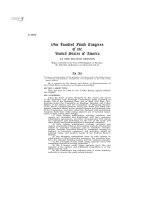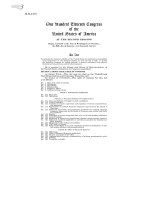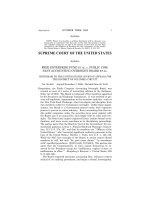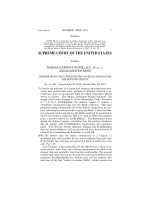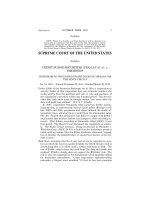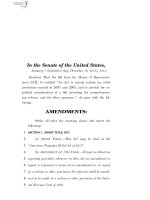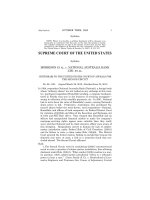SUPREME COURT OF THE UNITED STATES - RADLAX GATEWAY HOTEL, LLC, ET AL. v. AMALGAMATED BANK potx
Bạn đang xem bản rút gọn của tài liệu. Xem và tải ngay bản đầy đủ của tài liệu tại đây (97.62 KB, 12 trang )
1
(Slip Opinion) OCTOBER TERM, 2011
Syllabus
NOTE: Where it is feasible, a syllabus (headnote) will be released, as is
being done in connection with this case, at the time the opinion is issued.
The syllabus constitutes no part of the opinion of the Court but has been
prepared by the Reporter of Decisions for the convenience of the reader.
See United States v. Detroit Timber & Lumber Co., 200 U. S. 321, 337.
SUPREME COURT OF THE UNITED STATES
Syllabus
RADLAX GATEWAY HOTEL, LLC, ET AL. v.
AMALGAMATED BANK
CERTIORARI TO THE UNITED STATES COURT OF APPEALS FOR
THE SEVENTH CIRCUIT
No. 11–166. Argued April 23, 2012—Decided May 29, 2012
To finance the purchase of a commercial property and associated reno-
vation and construction costs, petitioners (debtors) obtained a se-
cured loan from an investment fund, for which respondent (Bank)
serves as trustee. The debtors ultimately became insolvent, and
sought relief under Chapter 11 of the Bankruptcy Code. Pursuant
to 11 U. S. C. §1129(b)(2)(A), the debtors sought to confirm a
“cramdown” bankruptcy plan over the Bank’s objection. That plan
proposed selling substantially all of the debtors’ property at an auc-
tion, and using the sale proceeds to repay the Bank. Under the debt-
ors’ proposed auction procedures, the Bank would not be permitted to
bid for the property using the debt it is owed to offset the purchase
price, a practice known as “credit-bidding.” The Bankruptcy Court
denied the debtors’ request, concluding that the auction procedures
did not comply with §1129(b)(2)(A)’s requirements for cramdown
plans. The Seventh Circuit affirmed, holding that §1129(b)(2)(A)
does not permit debtors to sell an encumbered asset free and clear of
a lien without permitting the lienholder to credit-bid.
Held: The debtors may not obtain confirmation of a Chapter 11
cramdown plan that provides for the sale of collateral free and clear
of the Bank’s lien, but does not permit the Bank to credit-bid at the
sale. Pp. 3–10.
(a) A Chapter 11 plan proposed over the objection of a “class of se-
cured claims” must meet one of three requirements in order to be
deemed “fair and equitable,” and therefore confirmable. The secured
creditor may retain its lien on the property and receive deferred cash
payments, §1129(b)(2)(A)(i); the debtors may sell the property free
and clear of the lien, “subject to section 363(k)”—which permits the
2 RADLAX GATEWAY HOTEL, LLC v. AMALGAMATED BANK
Syllabus
creditor to credit-bid at the sale—and provide the creditor with a lien
on the sale proceeds, §1129(b)(2)(A)(ii); or the plan may provide the
secured creditor with the “indubitable equivalent” of its claim,
§1129(b)(2)(A)(iii).
Here, the debtors proposed to sell their property free and clear of
the Bank’s liens and repay the Bank with the sale proceeds, as con-
templated by clause (ii). Because the debtors’ auction procedures do
not permit the Bank to credit-bid, however, the proposed sale cannot
satisfy the requirements of clause (ii). The debtors claim their plan
can instead satisfy clause (iii) by providing the Bank with the “indu-
bitable equivalent” of its secured claim, in the form of cash generated
by the auction.
The debtors’ reading of §1129(b)(2)(A), under which clause (iii)
permits precisely what clause (ii) proscribes, is hyperliteral and con-
trary to common sense. “[I]t is a commonplace of statutory construc-
tion that the specific governs the general.” Morales v. Trans World
Airlines, Inc., 504 U. S. 374, 384. Here, where general and specific
authorizations exist side-by-side, the general/specific canon avoids
rendering superfluous a specific provision that is swallowed by the
general one. See D. Ginsberg & Sons, Inc. v. Popkin, 285 U. S. 204,
208. As applied to §1129(b)(2)(A), the canon provides that the “gen-
eral language” of clause (iii), “although broad enough to include it,
will not be held to apply to a matter specifically dealt with” in clause
(ii). 285 U. S., at 208. Although the canon can be overcome by other
textual indications of statutory meaning, the debtors point to none
here. Pp. 3–8.
(b) None of the debtors’ objections to this approach is valid. Pp. 8–
9.
651 F. 3d 642, affirmed.
S
CALIA, J., delivered the opinion of the Court, in which all other
Members joined, except K
ENNEDY, J., who took no part in the decision of
the case.
_________________
_________________
1 Cite as: 566 U. S. ____ (2012)
Opinion of the Court
NOTICE: This opinion is subject to formal revision before publication in the
preliminary print of the United States Reports. Readers are requested to
notify the Reporter of Decisions, Supreme Court of the United States, Wash-
ington, D. C. 20543, of any typographical or other formal errors, in order
that corrections may be made before the preliminary print goes to press.
SUPREME COURT OF THE UNITED STATES
No. 11–166
RADLAX GATEWAY HOTEL, LLC, ET AL., PETITION-
ERS v. AMALGAMATED BANK
ON WRIT OF CERTIORARI TO THE UNITED STATES COURT OF
APPEALS FOR THE SEVENTH CIRCUIT
[May 29, 2012]
JUSTICE SCALIA delivered the opinion of the Court.
We consider whether a Chapter 11 bankruptcy plan may
be confirmed over the objection of a secured creditor pur-
suant to 11 U. S. C. §1129(b)(2)(A) if the plan provides
for the sale of collateral free and clear of the creditor’s lien,
but does not permit the creditor to “credit-bid” at the sale.
I
In 2007, petitioners RadLAX Gateway Hotel, LLC, and
RadLAX Gateway Deck, LLC (hereinafter debtors), pur-
chased the Radisson Hotel at Los Angeles International
Airport, together with an adjacent lot on which the debtors
planned to build a parking structure. To finance the
purchase, the renovation of the hotel, and construction of
the parking structure, the debtors obtained a $142 million
loan from Longview Ultra Construction Loan Investment
Fund, for which respondent Amalgamated Bank (hereinaf-
ter creditor or Bank) serves as trustee. The lenders ob-
tained a blanket lien on all of the debtors’ assets to secure
the loan.
Completing the parking structure proved more expen-
sive than anticipated, and within two years the debtors
2 RADLAX GATEWAY HOTEL, LLC v. AMALGAMATED BANK
Opinion of the Court
had run out of funds and were forced to halt construction.
By August 2009, they owed more than $120 million on the
loan, with over $1 million in interest accruing every month
and no prospect for obtaining additional funds to complete
the project. Both debtors filed voluntary petitions for
relief under Chapter 11 of the Bankruptcy Code.
A Chapter 11 bankruptcy is implemented according to
a “plan,” typically proposed by the debtor, which divides
claims against the debtor into separate “classes” and
specifies the treatment each class will receive. See 11
U. S. C. §1123. Generally, a bankruptcy court may con-
firm a Chapter 11 plan only if each class of creditors af-
fected by the plan consents. See §1129(a)(8). Section
1129(b) creates an exception to that general rule, per-
mitting confirmation of nonconsensual plans—commonly
known as “cramdown” plans—if “the plan does not dis-
criminate unfairly, and is fair and equitable, with respect
to each class of claims or interests that is impaired under,
and has not accepted, the plan.” Section 1129(b)(2)(A),
which we review in further depth below, establishes crite-
ria for determining whether a cramdown plan is “fair and
equitable” with respect to secured claims like the Bank’s.
In 2010, the RadLAX debtors submitted a Chapter 11
plan to the United States Bankruptcy Court for the
Northern District of Illinois. The plan proposed to dissolve
the debtors and to sell substantially all of their assets
pursuant to procedures set out in a contemporaneously
filed “Sale and Bid Procedures Motion.” Specifically, the
debtors sought to auction their assets to the highest bid-
der, with the initial bid submitted by a “stalking horse”—a
potential purchaser who was willing to make an advance
bid of $47.5 million.
1
The sale proceeds would be used to
fund the plan, primarily by repaying the Bank. Of course
——————
1
In a later proposal, the stalking-horse bid increased to $55 million.
The precise amount of the bid is not relevant here.
Cite as: 566 U. S. ____ (2012) 3
Opinion of the Court
the Bank itself might wish to obtain the property if
the alternative would be receiving auction proceeds that
fall short of the property’s full value. Under the debtors’
proposed auction procedures, however, the Bank would
not be permitted to bid for the property using the debt it is
owed to offset the purchase price, a practice known as
“credit-bidding.” Instead, the Bank would be forced to bid
cash. Correctly anticipating that the Bank would object to
this arrangement, the debtors sought to confirm their plan
under the cramdown provisions of §1129(b)(2)(A).
The Bankruptcy Court denied the debtors’ Sale and Bid
Procedures Motion, concluding that the proposed auction
procedures did not comply with §1129(b)(2)(A)’s require-
ments for cramdown plans. In re River Road Hotel Part-
ners, LLC, Case No. 09 B 30029 (ND Ill., Oct. 5, 2010),
App. to Pet. for Cert. 40a. The Bankruptcy Court certified
an appeal directly to the United States Court of Appeals
for the Seventh Circuit. That court accepted the certifi-
cation and affirmed, holding that §1129(b)(2)(A) does not
permit debtors to sell an encumbered asset free and clear
of a lien without permitting the lienholder to credit-bid.
River Road Hotel Partners, LLC, et al. v. Amalgamated
Bank, 651 F. 3d 642 (2011). We granted certiorari. 565
U. S. ___ (2011).
II
A
A Chapter 11 plan confirmed over the objection of a
“class of secured claims” must meet one of three require-
ments in order to be deemed “fair and equitable” with
respect to the nonconsenting creditor’s claim. The plan
must provide:
“(i)(I) that the holders of such claims retain the
liens securing such claims, whether the property sub-
ject to such liens is retained by the debtor or trans-
ferred to another entity, to the extent of the allowed
4 RADLAX GATEWAY HOTEL, LLC v. AMALGAMATED BANK
Opinion of the Court
amount of such claims; and (II) that each holder of a
claim of such class receive on account of such claim
deferred cash payments totaling at least the allowed
amount of such claim, of a value, as of the effective
date of the plan, of at least the value of such holder’s
interest in the estate’s interest in such property;
“(ii) for the sale, subject to section 363(k) of this ti-
tle, of any property that is subject to the liens secur-
ing such claims, free and clear of such liens, with such
liens to attach to the proceeds of such sale, and the
treatment of such liens on proceeds under clause (i) or
(iii) of this subparagraph; or
“(iii) for the realization by such holders of the
indubitable equivalent of such claims.” 11 U. S. C.
§1129(b)(2)(A).
Under clause (i), the secured creditor retains its lien on
the property and receives deferred cash payments. Under
clause (ii), the property is sold free and clear of the lien,
“subject to section 363(k),” and the creditor receives a lien
on the proceeds of the sale. Section 363(k), in turn, pro-
vides that “unless the court for cause orders otherwise
the holder of such claim may bid at such sale, and, if the
holder of such claim purchases such property, such holder
may offset such claim against the purchase price of such
property”—i.e., the creditor may credit-bid at the sale, up
to the amount of its claim.
2
Finally, under clause (iii), the
plan provides the secured creditor with the “indubitable
equivalent” of its claim.
——————
2
The ability to credit-bid helps to protect a creditor against the risk
that its collateral will be sold at a depressed price. It enables the
creditor to purchase the collateral for what it considers the fair market
price (up to the amount of its security interest) without committing
additional cash to protect the loan. That right is particularly important
for the Federal Government, which is frequently a secured creditor in
bankruptcy and which often lacks appropriations authority to throw
good money after bad in a cash-only bankruptcy auction.
5 Cite as: 566 U. S. ____ (2012)
Opinion of the Court
The debtors in this case have proposed to sell their
property free and clear of the Bank’s liens, and to repay
the Bank using the sale proceeds—precisely, it would
seem, the disposition contemplated by clause (ii). Yet
since the debtors’ proposed auction procedures do not
permit the Bank to credit-bid, the proposed sale cannot
satisfy the requirements of clause (ii).
3
Recognizing this
problem, the debtors instead seek plan confirmation pur-
suant to clause (iii), which—unlike clause (ii)—does not
expressly foreclose the possibility of a sale without credit-
bidding. According to the debtors, their plan can satisfy
clause (iii) by ultimately providing the Bank with the
“indubitable equivalent” of its secured claim, in the form of
cash generated by the auction.
We find the debtors’ reading of §1129(b)(2)(A)—under
which clause (iii) permits precisely what clause (ii) pro-
scribes—to be hyperliteral and contrary to common sense.
A well established canon of statutory interpretation suc-
cinctly captures the problem: “[I]t is a commonplace of
statutory construction that the specific governs the gen-
eral.” Morales v. Trans World Airlines, Inc., 504 U. S.
374, 384 (1992). That is particularly true where, as in
§1129(b)(2)(A), “Congress has enacted a comprehensive
scheme and has deliberately targeted specific problems
with specific solutions.” Varity Corp. v. Howe, 516 U. S.
489, 519 (1996) (T
HOMAS, J., dissenting); see also HCSC-
Laundry v. United States, 450 U. S. 1, 6 (1981) (per
curiam) (the specific governs the general “particularly
when the two are interrelated and closely positioned,
both in fact being parts of [the same statutory scheme]”).
The general/specific canon is perhaps most frequently
——————
3
Title 11 U. S. C. §363(k)—and by extension clause (ii)—provides an
exception to the credit-bidding requirement if “the court for cause
orders otherwise.” The Bankruptcy Court found that there was no
“cause” to deny credit-bidding in this case, and the debtors have not
appealed that disposition.
6 RADLAX GATEWAY HOTEL, LLC v. AMALGAMATED BANK
Opinion of the Court
applied to statutes in which a general permission or pro-
hibition is contradicted by a specific prohibition or permis-
sion. To eliminate the contradiction, the specific provision
is construed as an exception to the general one. See, e.g.,
Morton v. Mancari, 417 U. S. 535, 550–551 (1974). But
the canon has full application as well to statutes such as
the one here, in which a general authorization and a more
limited, specific authorization exist side-by-side. There
the canon avoids not contradiction but the superfluity of
a specific provision that is swallowed by the general one,
“violat[ing] the cardinal rule that, if possible, effect shall
be given to every clause and part of a statute.” D. Gins-
berg & Sons, Inc. v. Popkin, 285 U. S. 204, 208 (1932).
The terms of the specific authorization must be complied
with. For example, in the last cited case a provision of the
Bankruptcy Act prescribed in great detail the procedures
governing the arrest and detention of bankrupts about
to leave the district in order to avoid examination. The
Court held that those prescriptions could not be avoided
by relying upon a general provision of the Act authoriz-
ing bankruptcy courts to “ ‘make such orders, issue such
process, and enter such judgments in addition to those spe-
cifically provided for as may be necessary for the enforce-
ment of the provisions of [the] Act.’” Id., at 206 (quoting
Bankruptcy Act of 1898, §2(15), 30 Stat. 546). The Court
said that “[g]eneral language of a statutory provision,
although broad enough to include it, will not be held to
apply to a matter specifically dealt with in another part
of the same enactment.” 285 U. S., at 208. We recently
quoted that language approvingly in Bloate v. United
States, 559 U. S. ___, ___ (2010) (slip op., at 10). Or as we
said in a much earlier case:
“It is an old and familiar rule that, where there is, in
the same statute, a particular enactment, and also a
general one, which, in its most comprehensive sense,
7 Cite as: 566 U. S. ____ (2012)
Opinion of the Court
would include what is embraced in the former, the
particular enactment must be operative, and the gen-
eral enactment must be taken to affect only such cases
within its general language as are not within the pro-
visions of the particular enactment. This rule applies
wherever an act contains general provisions and also
special ones upon a subject, which, standing alone, the
general provisions would include.” United States v.
Chase, 135 U. S. 255, 260 (1890) (citations and inter-
nal quotation marks omitted).
Here, clause (ii) is a detailed provision that spells out
the requirements for selling collateral free of liens, while
clause (iii) is a broadly worded provision that says nothing
about such a sale. The general/specific canon explains
that the “general language” of clause (iii), “although broad
enough to include it, will not be held to apply to a matter
specifically dealt with” in clause (ii). D. Ginsberg & Sons,
Inc., supra, at 208.
Of course the general/specific canon is not an absolute
rule, but is merely a strong indication of statutory mean-
ing that can be overcome by textual indications that point
in the other direction. The debtors point to no such indi-
cation here. One can conceive of a statutory scheme in
which the specific provision embraced within a general
one is not superfluous, because it creates a so-called safe
harbor. The debtors effectively contend that that is the
case here—clause (iii) (“indubitable equivalent”) being the
general rule, and clauses (i) and (ii) setting forth proce-
dures that will always, ipso facto, establish an “indubita-
ble equivalent,” with no need for judicial evaluation. But
the structure here would be a surpassingly strange man-
ner of accomplishing that result—which would normally
be achieved by setting forth the “indubitable equivalent”
rule first (rather than last), and establishing the two safe
harbors as provisos to that rule. The structure here sug-
8 RADLAX GATEWAY HOTEL, LLC v. AMALGAMATED BANK
Opinion of the Court
gests, to the contrary, that (i) is the rule for plans under
which the creditor’s lien remains on the property, (ii) is
the rule for plans under which the property is sold free
and clear of the creditor’s lien, and (iii) is a residual provi-
sion covering dispositions under all other plans—for ex-
ample, one under which the creditor receives the property
itself, the “indubitable equivalent” of its secured claim.
Thus, debtors may not sell their property free of liens
under §1129(b)(2)(A) without allowing lienholders to
credit-bid, as required by clause (ii).
B
None of the debtors’ objections to this approach is valid.
The debtors’ principal textual argument is that
§1129(b)(2)(A) “unambiguously provides three distinct
options for confirming a Chapter 11 plan over the objec-
tion of a secured creditor.” Brief for Petitioners 15 (capi-
talization and bold typeface removed). With that much we
agree; the three clauses of §1129(b)(2)(A) are connected by
the disjunctive “or.” The debtors contend that our inter-
pretation of §1129(b)(2)(A) “transforms ‘or’ into ‘and.’ ”
Reply Brief for Petitioners 3. But that is not so. The
question here is not whether debtors must comply with
more than one clause, but rather which one of the three
they must satisfy. Debtors seeking to sell their property
free of liens under §1129(b)(2)(A) must satisfy the re-
quirements of clause (ii), not the requirements of both
clauses (ii) and (iii).
The debtors make several arguments against applying
the general/specific canon. They contend that clause (ii)
is no more specific than clause (iii), because the former
provides a procedural protection to secured creditors
(credit-bidding) while the latter provides a substantive
protection (indubitable equivalence). As a result, they say,
clause (ii) is not “a limiting subset” of clause (iii), which
(according to their view) application of the general/specific
9 Cite as: 566 U. S. ____ (2012)
Opinion of the Court
canon requires. Brief for Petitioners 30–31; Reply Brief
for Petitioners 5–6. To begin with, we know of no authori-
ty for the proposition that the canon is confined to situa-
tions in which the entirety of the specific provision is a
“subset” of the general one. When the conduct at issue
falls within the scope of both provisions, the specific pre-
sumptively governs, whether or not the specific provision
also applies to some conduct that falls outside the general.
In any case, we think clause (ii) is entirely a subset.
Clause (iii) applies to all cramdown plans, which include
all of the plans within the more narrow category described
in clause (ii).
4
That its requirements are “substantive”
whereas clause (ii)’s are “procedural” is quite beside the
point. What counts for application of the general/specific
canon is not the nature of the provisions’ prescriptions but
their scope.
Finally, the debtors contend that the Court of Appeals
conflated approval of bid procedures with plan confirma-
tion. Brief for Petitioners 39. They claim the right to
pursue their auction now, leaving it for the Bankruptcy
Judge to determine, at the confirmation stage, whether
the resulting plan (funded by auction proceeds) provides
the Bank with the “indubitable equivalent” of its secured
claim. Under our interpretation of §1129(b)(2)(A), how-
ever, that approach is simply a nonstarter. As a matter of
law, no bid procedures like the ones proposed here could
satisfy the requirements of §1129(b)(2)(A), and the distinc-
tion between approval of bid procedures and plan confir-
mation is therefore irrelevant.
——————
4
We are speaking here about whether clause (ii) is a subset for pur-
poses of determining whether the canon applies. As we have described
earlier, after applying the canon—ex post, so to speak—it ceases to be a
subset, governing a situation to which clause (iii) will no longer be
deemed applicable.
10 RADLAX GATEWAY HOTEL, LLC v. AMALGAMATED BANK
Opinion of the Court
III
The parties debate at some length the purposes of the
Bankruptcy Code, pre-Code practices, and the merits of
credit-bidding. To varying extents, some of those debates
also occupied the attention of the Courts of Appeals that
considered the question presented here. See, e.g., In re
Philadelphia Newspapers, LLC, 599 F. 3d 298, 314–317
(CA3 2010); id., at 331–337 (Ambro, J., dissenting). But
nothing in the generalized statutory purpose of protecting
secured creditors can overcome the specific manner of that
protection which the text of §1129(b)(2)(A) contains. As
for pre-Code practices, they can be relevant to the inter-
pretation of an ambiguous text, but we find no textual
ambiguity here. And the pros and cons of credit-bidding
are for the consideration of Congress, not the courts.
The Bankruptcy Code standardizes an expansive (and
sometimes unruly) area of law, and it is our obligation to
interpret the Code clearly and predictably using well
established principles of statutory construction. See
United States v. Ron Pair Enterprises, Inc., 489 U. S. 235,
240–241 (1989). Under that approach, this is an easy case.
Because the RadLAX debtors may not obtain confirmation
of a Chapter 11 cramdown plan that provides for the sale
of collateral free and clear of the Bank’s lien, but does not
permit the Bank to credit-bid at the sale, we affirm the
judgment of the Court of Appeals.
It is so ordered.
J
USTICE KENNEDY took no part in the decision of this
case.
